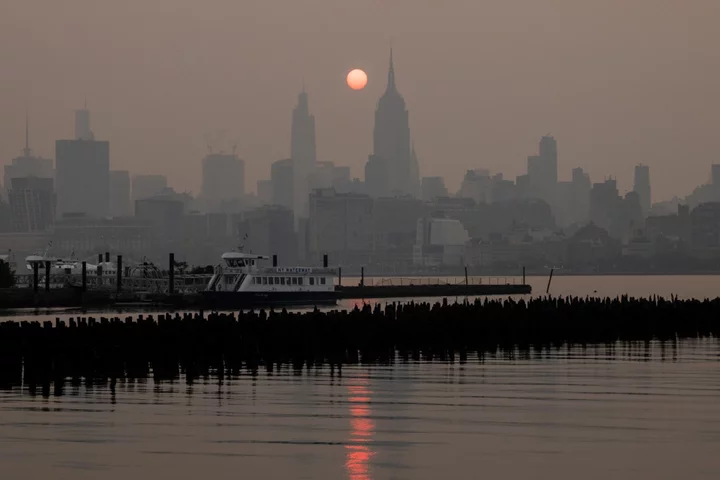Health officials across the US Northeast are warning residents to take precautions after wildfire smoke traveling south from Canada unleashed unhealthy air quality levels that pose a risk to the sick, elderly and young children.
New York City officials canceled outdoor school recess and suggested the most vulnerable wear high quality masks after a thick haze that blanketed skies triggered an overnight purple alert, the highest and most dangerous level. The health warning may last for at least another day, Mayor Eric Adams said in a press conference. Massachusetts, Maryland, Pennsylvania, New Jersey and Washington, DC, leaders also issued warnings.
Airborne particles and toxins can cause complications for patients with lung diseases such as asthma and chronic obstructive pulmonary disease as well as cardiovascular illness, and can be more serious for young children and older people. Levels are currently high enough that otherwise healthy humans and even pets are likely to experience some eye irritation and coughing, said Daniel Horton, director of Northwestern University’s Climate Change Research Group in Chicago.
“These extreme events have a particularly acute impact on humans and human health,” he said in a telephone interview. “What we often see at hospitals is an uptick in people arriving because of respiratory problems or heart problems.”
Annually, air pollution is estimated to account for about 100,000 US deaths, according to a 2020 study published in the journal Environmental Science and Technology Letters. Research by the Environmental Protection Agency and others has found that exposure to increased concentrations of particulate matter — even over a few hours to weeks — can trigger cardiovascular disease-related heart attacks and death.
One recent study found that a pandemic-related decrease in US air pollution during lockdowns was associated with fewer heart attacks. With each 10 microgram per cubic meter drop in tiny, airborne particles called PM2.5, the number of heart attacks decreased by 6%, according to the results, which were published in the Journal of the American Heart Association last year.
400 Wildfires
More than 400 wildfires are burning across Canada, from British Columbia in the west to Nova Scotia in the east, forcing the evacuation of thousands of people. But air currents are also pushing smoke thousands of miles south into the US.
A similar haze settled across the Northeast in 2021 when smoke from fires on the West Coast blew across the country. But the current air quality is worse, said Peter DeCarlo, an associate professor of environmental health and engineering at Johns Hopkins University in Baltimore.
Smoke traveling from the West Coast “has a little bit more time to dilute,” DeCarlo said. “Because the fires are so much closer in Quebec and Ontario and the smoke is being drawn straight into the eastern seaboard, we’re seeing much higher concentrations of particulate matter from these fires.”
The smoky haze is likely to remain for the rest of the week given current weather patterns, before blowing out toward the ocean, said Daniel Westervelt, an assistant research professor at Columbia University’s Lamont Doherty Earth Observatory in Palisades, NY.
“I would expect things to start to get a little bit better as we get closer to the weekend, but the fires are still burning,” Westervelt said. Changing weather patterns may bring “a little bit of relief, but it’s not going to be an overnight switch. It might take a a bit of time for all the smoke to clear out.”
Dangerous Mixture
Wildfire smoke holds a dangerous mixture of carbon monoxide and airborne particles. Smaller particles raise concerns as they can enter the lungs and even the bloodstream. New York has been registering high levels of PM2.5, the smallest particulate matter, since Tuesday.
On Tuesday evening the PM2.5 index reached above 200, levels rarely seen even in heavily polluted areas like Mexico City. Mexico’s capital is a basin surrounded by mountains that trap smog inside, and in the 1980s pollution was so dire that residents reported they saw birds falling from the sky.
There may still be room for the air quality to worsen today and later this week, said Suresh Dhaniyala, a professor at Clarkson University in Potsdam, New York who has been monitoring air quality. New York City’s particulate matter levels were as high as 75 micrograms per cubic meter Wednesday, five times the World Health Organization’s guidelines for average 24-hour levels, according to IQAir.
The health effects are particularly concerning for children with asthma, said Stephanie Lovinsky-Desir, chief of pediatric pulmonology at Columbia University Medical Center. Poor air quality can exacerbate asthma in the short-term, and chronic exposure is linked to smaller lung size, she said.
“This sets our kids up for risk of lung disease well into adulthood,” she said.
Those at risk may want to keep their windows closed and use air filters if they’re available, according to Lovinsky-Desir. For people who do not have the option to stay indoors, KN-95 or N-95 masks decrease inhalation exposure from particulate pollution, she said.
--With assistance from Laura Nahmias.
(Adds data on pollution and disease, deaths from fifth paragraph)
Author: Nacha Cattan, Madison Muller and Ilena Peng









